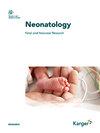一项大型回顾性队列研究中预测葡萄糖-6-磷酸脱氢酶缺陷婴儿需要光疗的危险因素
IF 3
3区 医学
Q1 PEDIATRICS
引用次数: 1
摘要
简介:葡萄糖-6-磷酸脱氢酶(G6PD)缺乏会增加新生儿患严重高胆红素血症的风险。本研究评估了预测G6PD缺陷新生儿72小时后需要光疗的风险因素,并评估了早期出院的安全性。方法:对681名出生体重≥2500 g、4年以上的足月G6PD缺陷婴儿进行回顾性队列研究。我们比较了需要光疗组(A组)和不需要光疗的组(B组)的基线特征、第4天(生命72小时后)的胆红素水平、胆红素峰值日、G6PD水平以及伴随的ABO血型不合。结果:396名婴儿(58%),主要是男性,在出生后的第一周需要接受光疗。与对照组相比,需要光疗的婴儿的中位胎龄较低(38.3 vs.38.7周,p<0.01),G6PD水平较低(2.3±2.5 vs.3±3.4 IU,p<0.05)。平均第4天血清总胆红素(TSB)水平更高(213±32 vs.151±37µmol/L,p<0.01),A组的胆红素水平峰值更早(3 vs.4天,p<0.01)。回归分析确定,第4天的TSB水平、中国种族、妊娠期较低以及伴随的ABO血型不合是研究人群需要光疗的重要预测因素。特别是,共存的ABO血型不合增加了需要光疗的黄疸风险(OR 4.27,95%CI:1.98-121,p<0.01)。第四天TSB值高于180µmol/L预测需要光疗,灵敏度为86%,特异性为80%。G6PD缺乏症的男性和女性婴儿的研究结果相似。结论:第四天TSB水平>180µmol/L(10.5 mg/dL)且相关ABO血型不合的G6PD缺陷婴儿在出生后第一周需要光疗的风险更高,应密切监测。本文章由计算机程序翻译,如有差异,请以英文原文为准。
Risk Factors Predicting the Need for Phototherapy in Glucose 6 Phosphate Dehydrogenase-Deficient Infants in a Large Retrospective Cohort Study
Introduction: Glucose 6-phosphate dehydrogenase (G6PD) deficiency increases the risk of severe neonatal hyperbilirubinemia. This study evaluates the risk factors predicting the need for phototherapy in G6PD-deficient neonates after 72 h of age and assesses the safety of early discharge. Methods: A retrospective cohort study of 681 full-term G6PD-deficient infants with a birth weight ≥2,500 g over 4 years was conducted. We compared the baseline characteristics, bilirubin level on day 4 (after 72 h of life), day of peak bilirubin, G6PD levels, and concomitant ABO incompatibility between the group that required phototherapy (Group A) and those who did not (Group B). Results: 396 infants (58%), predominantly males, required phototherapy in the first week of life. The infants who required phototherapy had a lower median gestational age (38.3 vs. 38.7 weeks, p < 0.01) and had lower G6PD levels (2.3 ± 2.5 vs. 3 ± 3.4 IU, p < 0.05) compared to the controls. The mean day-four total serum bilirubin (TSB) levels were higher (213 ± 32 vs. 151 ± 37 µmol/L, p < 0.01), with bilirubin level peaking earlier (3 vs. 4 days of life, p < 0.01) in group A. Regression analysis identified TSB levels on day 4, Chinese race, lower gestation, and concomitant ABO incompatibility as the significant predictors for the need for phototherapy in the study population. In particular, coexisting ABO blood group incompatibility increased the risk of jaundice requiring phototherapy (OR 4.27, 95% CI: 1.98–121, p < 0.01). Day four TSB values above 180 µmol/L predicted the need for phototherapy with 86% sensitivity and 80% specificity. The findings were similar across both male and female infants with G6PD deficiency. Conclusion: G6PD-deficient infants with day four TSB levels of >180 µmol/L (10.5 mg/dL) and associated ABO blood group incompatibility have a higher risk of requiring phototherapy in the first week of life and should be closely monitored.
求助全文
通过发布文献求助,成功后即可免费获取论文全文。
去求助
来源期刊

Neonatology
医学-小儿科
CiteScore
0.60
自引率
4.00%
发文量
91
审稿时长
6-12 weeks
期刊介绍:
This highly respected and frequently cited journal is a prime source of information in the area of fetal and neonatal research. Original papers present research on all aspects of neonatology, fetal medicine and developmental biology. These papers encompass both basic science and clinical research including randomized trials, observational studies and epidemiology. Basic science research covers molecular biology, molecular genetics, physiology, biochemistry and pharmacology in fetal and neonatal life. In addition to the classic features the journal accepts papers for the sections Research Briefings and Sources of Neonatal Medicine (historical pieces). Papers reporting results of animal studies should be based upon hypotheses that relate to developmental processes or disorders in the human fetus or neonate.
 求助内容:
求助内容: 应助结果提醒方式:
应助结果提醒方式:


